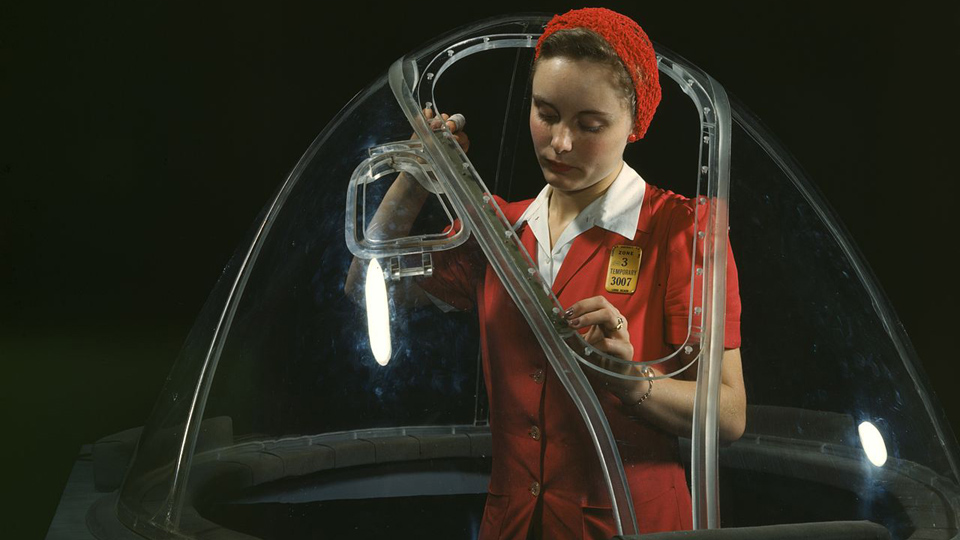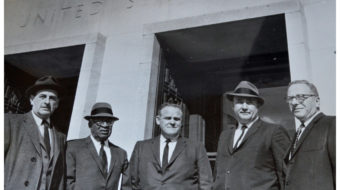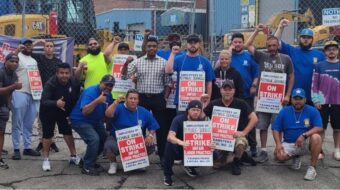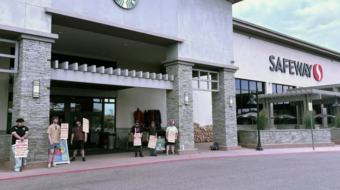
Seventy-five years ago, on December 15, 1941, the Executive Council of the American Federation of Labor unanimously voted for a no-strike policy in war industries. The December 7th attack on Pearl Harbor led to a U.S. declaration of war against Japan, and a few days later to war against fascist Germany and Italy.
Within days after the attack, President Roosevelt called for a meeting of labor and industry representatives to agree on a war labor policy that would “prevent the interruption of production by labor disputes during the period of the war.”
One hundred AFL union leaders immediately extended the no-strike policy to their entire 5 million membership.
AFL President William Green said, “Labor knows its duty. It will do its duty, and more. No new laws are necessary to prevent strikes. Labor will see to that. American workers will now produce as the workers of no other country have ever produced.”
In a radio speech on December 8, Philip Murray, president of the Congress of Industrial Organizations (CIO), said that CIO members “were ready and eager to do their utmost to defend our country against the outrageous aggression of Japanese imperialism, and to secure the final defeat of the forces of Hitler.” He was, however, careful to note that “they of course expect reciprocity, and that no selfish advantage will be taken of the sacrifices they are prepared to make.”
The entry of the U.S. into World War II brought near-total unanimity among the varying factions of the American labor movement. The AFL and the CIO, the country’s largest and most influential labor associations, were bitter enemies before the war, with antagonism over principled differences such as craft (skilled) versus industrial (semiskilled and unskilled) unionism. Although labor conflicts did break out occasionally, the promised “no-strike pledge” largely held for the duration. Putting class conflict aside for the time being, the left adopted the mantra, “Shove the profits down the bosses’ throats,” if that’s what it would take to win the war.
Meetings between labor and management began on December 17, resulting in an unconditional no-strike pledge from organized labor and a no-lockout pledge from management. The meetings, however, foundered on management’s refusal to accept any kind of union security. Unions could not afford to give up some form of union security going into a period when they were likely to win very little for their members. Roosevelt simply accepted those points on which there was agreement and dismissed the conference, codifying its conclusions as follows: “1. There shall be no strikes or lockouts. 2. All disputes shall be settled by peaceful means. 3. The President shall set up a proper War Labor Board to handle these disputes.”
Even though the country stood united against Germany and Japan, the no-strike pledge complicated the lives of union workers. The initial shock of being attacked on U.S. territory, along with early Allied military setbacks, helped to control pre-existing tensions in the workplace. Beginning in 1943, however, as Allied forces gradually gained traction, disputes within labor, from the rank and file as well as from the leaders, became more apparent. Union leaders, especially within the AFL and CIO, were stuck in the middle, as allies of the government and corporations, and as representatives of their members.
The lingering unemployment remaining from the Great Depression ended with the mobilization for war. Out of a labor force of 54 million, joblessness fell in half from 7.7 million in spring 1940 to 3.4 million in fall 1941, and fell in half again to 1.5 million in fall 1942, hitting an all-time low of 700,000 in fall 1944. There was a growing labor shortage in war centers, where sound trucks roamed the streets begging for people to apply for war jobs.
Greater wartime production created millions of new jobs, while the draft reduced the number of young men available for civilian jobs. So great was the demand for labor that millions of retired people, housewives, and students entered the labor force, lured by patriotism and wages. Both the CIO and the larger AFL grew rapidly in the war years.
Most unions fully supported both the war effort and the Roosevelt administration. Even though the complaints from union members about the no-strike pledge became louder and more bitter as the war endured, the labor movement did not abandon it. However, the United Mine Workers, who had taken an isolationist stand in the years leading up to the war and had opposed Roosevelt’s reelection in 1940, left the CIO in 1942. Miners threatened numerous strikes, including a successful 12-day strike in 1943. The strikes and threats made mine leader John L. Lewis a much hated man in some quarters and led to legislation hostile to unions.
All the major unions grew stronger during the war. The government put pressure on employers to recognize unions to avoid the sort of turbulent struggles over union recognition of the 1930s, while unions were generally able to obtain maintenance of membership clauses, a form of union security, through arbitration and negotiation. Employers gave workers new untaxed benefits (such as vacation time, pensions, and health insurance), which increased real incomes even when wage rates were frozen. The wage differential between higher skilled and less skilled workers narrowed, and with the enormous increase in overtime for blue collar wage workers (at time and a half pay), incomes in working class households shot up, while the salaried middle class lost ground.
These gains toward greater egalitarianism would produce, within a generation, what became the envy of the world, an overwhelmingly “middle-class” society such as never existed previously in history, although that did not characterize all sectors, such as African Americans in the Jim Crow South. Persistent racism was addressed by the Roosevelt Administration’s tentative efforts to remedy racial discrimination in war industries through the Fair Employment Practices Commission.
Gender discrimination in wartime industry persisted as well, which now employed many more women in nontraditional jobs. Most of the “Rosie the Riveters” were considered temporary wartime replacements for the men in the armed forces, and were forced back into domestic life after the war when the veterans came home.
The immediate post-war years saw the breakout of huge national strikes owing to the pent-up demands from the no-strike period. Some skeptics later questioned the no-strike policy in that it helped to establish a permanent social contract between labor and capital that, in their view, simply meant that labor was bought off. Labor thus became capital’s willing partner in the post-war construction of American hegemony during the Cold War.
In any case, the “permanence” of that contract is now destroyed. Global capital has almost entirely abandoned, except rhetorically, its allegiance to the idea of a national workforce. In the new era, class conflict has become internationalized.
Sources: Martin Glaberman, Wartime Strikes: The Struggle Against the No-Strike Pledge in the UAW During World War II, Wikipedia, and St. James Encyclopedia of Labor History Worldwide.










